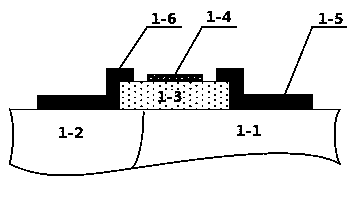Programmable Non-Volatile Memory and Its Application in Semiconductor Storage Devices
A non-volatile, memory technology, applied in the direction of semiconductor devices, electric solid state devices, electrical components, etc., to achieve the effect of high write life and high data retention life
- Summary
- Abstract
- Description
- Claims
- Application Information
AI Technical Summary
Problems solved by technology
Method used
Image
Examples
Embodiment 1
[0028] figure 1 In the most basic embodiment of the memory cell of the present invention, a diode comprising a substrate having a resistivity of about 1 Ω·cm and a thickness of about 1 μm. An anode region 1-1 of the p-type silicon layer and a cathode region 1-2 of the n-type silicon layer are respectively formed on the substrate. The aluminosilicate glass layer 1-3 is formed on the termination surface of the pn junction between the p-type anode region 1-1 and the n-type cathode region 1-2, and the doping concentration is 8*10 16 -2*10 17 cm -3 Na. It is covered with a 0.5um thick Ti-N-Si resistance heater 1-4, and the metal contacts 1-5, 1-6 are respectively connected to the anode area 1-1 and the cathode area 1-2. Standard mesa fabrication methods and techniques are used to form the described structures.
[0029] In the specific operation, the aluminosilicate glass layer 1-3 is heated by the resistance heater 1-4 covered above to increase the mobility of Na ions in it, a...
Embodiment 2
[0032] figure 2 As another basic embodiment of the memory cell of the present invention, a MOS transistor includes a p-type silicon substrate 2-1 with a resistivity of about 1Ω·cm and a thickness of about 1 μm, and an n-type silicon substrate formed on the substrate 2-1. type of source region 2-2 and drain region 2-3. The aluminosilicate layer 2-4 (gate insulating layer) is about 0.5 μm thick, and the doping concentration is 8*10 16 -2*10 17 cm -3 Na, and covers part of the regions 2-1, 2-2, 2-3. The metal pole 2-5 and the resistance heater 2-6 made of Ti-N-Si are located on the aluminosilicate layer 2-4, and the metal contacts 2-7 and 2-8 are respectively connected to the source region 2-2 and drain regions 2-3, 0.8 μm thick SiO 2 Layer 2-9, covering the remainder of the top surface of substrate 2-1. The structures can be formed by mesa process methods and techniques.
[0033] In the specific operation, the aluminosilicate layer 2-4 is heated by the resistance heater ...
PUM
 Login to View More
Login to View More Abstract
Description
Claims
Application Information
 Login to View More
Login to View More - R&D
- Intellectual Property
- Life Sciences
- Materials
- Tech Scout
- Unparalleled Data Quality
- Higher Quality Content
- 60% Fewer Hallucinations
Browse by: Latest US Patents, China's latest patents, Technical Efficacy Thesaurus, Application Domain, Technology Topic, Popular Technical Reports.
© 2025 PatSnap. All rights reserved.Legal|Privacy policy|Modern Slavery Act Transparency Statement|Sitemap|About US| Contact US: help@patsnap.com



